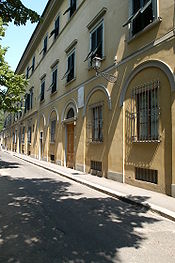 The 2012 ASM Summer School will focus on major historical monuments and the art productions of the territory today known as Uzbekistan, an area that for centuries played a central role in the trade routes connecting China to the Mediterranean and Europe, either through land or via the sea. It had an important position in the pre-modern global trade connecting varied regions, such as East Africa, the Indian Subcontinent, Iran and the Levant.
The 2012 ASM Summer School will focus on major historical monuments and the art productions of the territory today known as Uzbekistan, an area that for centuries played a central role in the trade routes connecting China to the Mediterranean and Europe, either through land or via the sea. It had an important position in the pre-modern global trade connecting varied regions, such as East Africa, the Indian Subcontinent, Iran and the Levant.
Located in an eminent geographical and cultural sphere, present-day Uzbekistan has become the intermediary space between three continents and could be regarded as the medi-terranean space, a space that mediates between different terrae (lands). As a particular zone of interaction, it developed a artistic and aesthetic language, in which different traditions were amalgamated in a manner that highlights the negotiability in art transfers. « Trading » with artistic heritages, be it Buddhist or Zoroastrian sacred art and imperial pre-Islamic wall paintings, arts produced under the power of Islam or according to nomadic traditions, this area is one of the best testimonies for the cultural interactions of central Asia, their polyvalences and, moreover, the mobility of art and ideas along the economical and migration routes of the pre-modern era. The cross-cultural phenomenon seems to gain a new dimension with the establishing and consolidation of the Mongol empire in the thirteenth and fourteenth centuries, stretching from China to eastern Europe. In these specific moments important centers like Tabriz, Isfahan, Shiraz, Heart, Baghdad, and even Delhi, became part of a huge new empire. Following the « heroes » of the great conquest era, starting with Genghis Khan (d. 1270), Timur (1336-1405), who was born in Shakhrisyabz, and his follower Ulugh Beg (1394-1449), appropriated the Mongol tradition and transformed the space that is now Uzbekistan from a main crossroads to a stable flourishing centre. Samarkand, for example, under Ulugh Beg became the center of scientific, artistic and literary enterprises, bridging China and the Mediterranean – a Muslim « Renaissance » city that could easily be compared with Florence or Granada.
From the 19th century up to the present, there have been various national and political-ideological appropriations of Central Asia’s past and its artistic production. Indeed, in modern Uzbekistan, the idea of cultural diversity is mobilized in the construction of a national identity. However, this concept is built on the image of Timur, a monarch with the claim of absolute power, thus introducing the concept of unity and indirectly the idea of monocracy into the contemporary national discourse. This specific political constellation has a strong impact on the restoration of surviving historical monuments from the Soviet time until today and on the writing of art historical narratives about the region.
The summer school will question the traditional narratives through a thorough examination of the monuments from a comparative perspective, analysing specific constructions of and references to the past, as well as the mobility of forms and aesthetic values in a broader Mediterranean and Asian context. It will investigate the particular dynamics of the arts within premodern forms of mobility and their participation in the construction and transformation of spaces. In addition, it will include a critical discussion of the historiography of this geo-cultural space and the making, or rather the ideological reconstruction, of its own past.
Places to be visited: Tashkent, Terminz, Samarkand, Afrosiab, Shakhrisyabz, Bukhara and Chiva.
The summer school is part of the research program « Art, Space and Mobility in Early Ages of Globalization. The Mediterranean, Central Asia and the Indian Subcontinent 400-1650 » directed by Gerhard Wolf, Hannah Baader and Avinoam Shalem from the KHI in Florence, in collaboration with the Getty Foundation. It welcomes students and young scholars working in Western, Islamic, Asian or Byzantine Art History, including graduate students, doctoral candidates and scholars embarking on post-doctoral research.
Each participant is expected to contribute to the success of the course not only by presenting a paper but also by actively participating in discussions, which will be held in English and French. Accommodation and travel costs will be covered.
Applications should include a letter of interest, a curriculum vitae and the name of a referee. Graduate students not yet involved in dissertation research should attach a summary of their course work. Pre and post-doctoral applicants should provide a brief summary of their research project (250-300 words). Topic suggestions will be provided, but all participants are encouraged to include their own proposal (250-300 words), which we will try to include in the program.
Applications should be sent via email to asm@khi.fi.it before November 13, 2011. Notifications of acceptance will be sent by December 15, 2011.
URL de référence : http://www.khi.fi.it/en/ausschreibungen/stellenangebote/stellenangebot86/index.html

Leave a Reply
You must be logged in to post a comment.